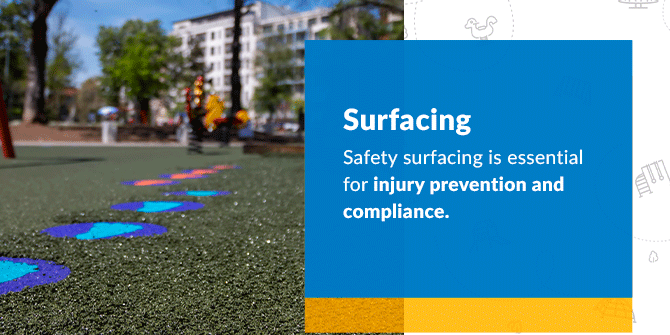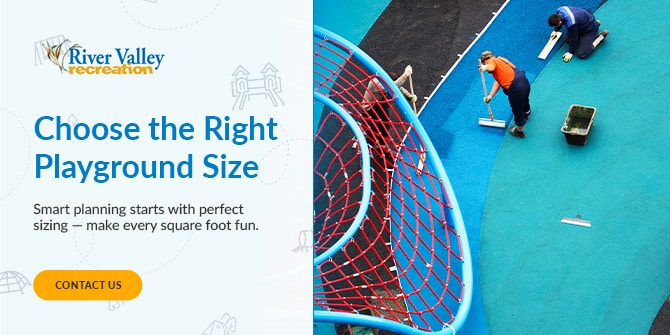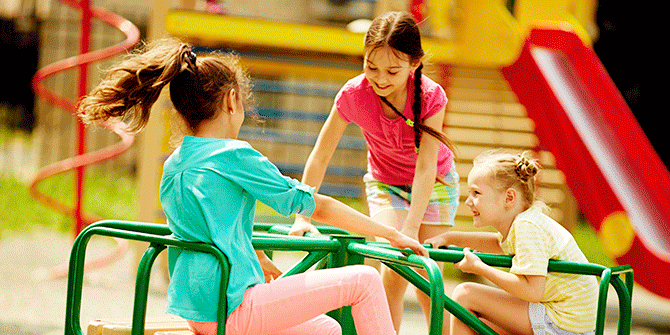Playgrounds offer opportunities for children to develop physically and socially. Some play elements promote sensory regulation, while others strengthen the core, arms and legs. Playgrounds also enable kids to interact with others of the same age and engage in creative and imaginative environments. However, implementing the right equipment is crucial for maximizing benefits for your community.
This guide will walk through the steps and considerations necessary to select appropriate playground sizes to meet your specific community and location needs.
Why Playground Size Matters
Dedicating the right amount of space for playground equipment ensures that you can create a safe community space to encourage diverse activities and support skills development while avoiding overcrowding. A too-small playground may lack sufficient variety for your community, while too-large playgrounds can feel empty or fail to engage children.
Balancing available space with design and versatility allows you to budget appropriately and empowers you to create a space that serves your community for years to come.
Essential Factors to Consider for Playground Size
Creating an ideal playground requires tons of planning. Determining the right size of playground equipment starts with assessing your space and community needs. There is no one-size-fits-all strategy for sizing a playground — every community and space is different. Here are the top factors to consider:
Budget Restrictions
Budgeting for a playground means considering the initial build and the ongoing costs. Top financial factors to keep in mind while planning include:
- Playground elements: Assess costs associated with playground equipment, surfacing, installation and maintenance when budgeting. These costs vary greatly by complexity and size.
- Equipment phasing: Consider if you plan on upgrading your playground equipment or installing additional structures over time. Start with core equipment and surfacing, and construct a timeline and plan for implementing complementary pieces as necessary.
- Financing options: Determine how you will pay for your play area. Some equipment companies offer financing options, but you can also seek financial assistance. Schools and some public spaces may be eligible for grants to ease cost concerns. Consider community fundraisers and partnering with sponsors to make the project more affordable.
Available Space
One of the first steps in designing a play area is measuring your available space. Existing obstacles and nearby structures can impact the size of the playground area you can work with.
To measure for a playground set, begin by finding the space’s perimeter. If incorporating distinct play zones, you will need to evaluate how these requirements impact overall design and implementation. Consider whether you should opt for several smaller structures scattered throughout your available space or stick with one larger piece of play equipment.
Take note of any potential obstacles. For instance, you may be able to remove a tree to ensure adequate space, but you’ll have to work around features like utility poles.
Parks and public spaces should establish play areas near facilities and resources like restrooms and parking. Schools should consider how close the playground is to the main building and ensure staff can easily monitor all angles. Account for space to accommodate seating for parents or supervisors in your design.
Community Demographics
After collecting measurements, it’s time to identify user needs. This information will guide your design process. Start by determining your target age group. Middle school playgrounds will have different features than toddler play areas. If you’re catering to mixed ages, consider zoning to indicate age-appropriate equipment. Researching community demographics can help determine user needs. Prioritize accessibility requirements for children with disabilities.
Estimate the number of children who will use your equipment at peak times. Accurately forecasting these numbers will ensure you choose the right size playground to promote play while avoiding overcrowding.

Surfacing
Safety surfacing is essential for injury prevention and compliance. Choosing the right material and depth is critical. Common surfacing materials include pour-in-place rubber, rubber mulch and wood mulch. Each material has unique pros, cons and recommended surface depths based on equipment fall height.
Also consider how much space around a playground needs surfacing to ensure safety. Discuss requirements and options with your playground designer, and implement playground safety audits to ensure compliance.
The Pros and Cons of Different Playground Sizes
How big should your playground be? The right size will entertain your community and help you stay within your allotted budget.
Appropriately-sized play spaces will promote interactive play between children and offer independent opportunities. Regardless of the specific dimensions you opt for, you can create a well-designed play area by choosing interactive play elements based on your community’s needs.
Small Playgrounds
Small playground sizes are often under about 1,500 square feet. These playgrounds are ideal for smaller spaces, like:
- Daycare centers.
- Small parks.
- Rooftops.
- Apartment complexes.
- Urban areas.
Small playgrounds feature compact equipment and structures such as small slides, spring riders and climbing walls. These play areas are suitable for younger children who need space to walk, crawl and sit up. Thoughtful designs and multifunctional equipment can accommodate broader ranges, but small playgrounds will generally target specific ages.
Along with catering to specific age groups, small playgrounds can deliver benefits to facility managers and owners. Small play equipment will generally be less expensive than large play structures because it requires fewer manufactured materials, and transporting the pieces may be easier. Additionally, smaller play areas are often easier to maintain because there are fewer components needing attention.
Medium Playgrounds
Medium playground dimensions are typically between 1,500 and 5,000 square feet. These play areas are common in community centers, schoolyards and larger parks. Medium-sized playgrounds often feature various types of equipment to serve multiple age groups.
Equipment options could include:
- Larger climbing structures.
- Swing sets.
- Interactive play panels.
- Multiple slides.
These playgrounds can serve kids in varying developmental stages, so balancing space efficiency and diverse play is important. Designs should incorporate creative layouts that prevent overcrowding. Medium play spaces can also feature distinct play zones to indicate which spaces are age-appropriate for each group.
These play areas are more expensive than small playgrounds. However, medium-sized playgrounds can offer many benefits, such as offering a wider range of activities, accommodating more children and promoting social interaction.
Large Playgrounds
Large playgrounds often measure 5,000 square feet or more. These spaces offer extensive play options and can often accommodate 50 children or more. Recreational areas, regional parks, destination playgrounds and expansive community centers are great spaces for large playgrounds.
By including a vast selection of equipment and activity options, these playgrounds can cater to all age groups and interests. These play areas incorporate comprehensive play structures, climbing systems, inclusive play areas, theme play structures, multiple swing sets and unique elements like zip lines. Some spaces also incorporate nearby multisport areas or outdoor fitness equipment to serve older children and adults.
Larger spaces offer the most diverse play experiences for all kids. The blend of opportunities can attract more visitors, including those from surrounding areas. These playgrounds can become significant community hubs and foster social interaction between children, families and broader community members.
Choose the Right Playground Size for Your Public Space With River Valley Recreation
The right-sized playground can bring long-lasting value to your community. If you’re ready to plan your play area, connect with River Valley Recreation for expert guidance and assistance. We proudly serve schools, daycare centers, community parks, HOAs and landscape architects looking to implement safe and fun playground spaces.
Create an engaging play space for your community with us! Contact our team to get started.



